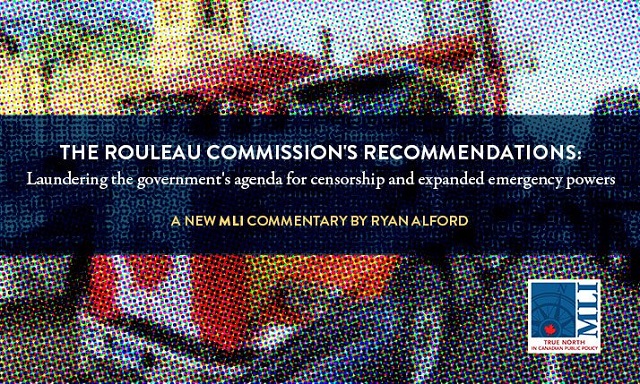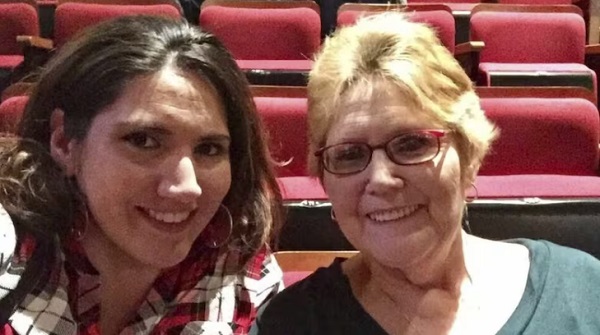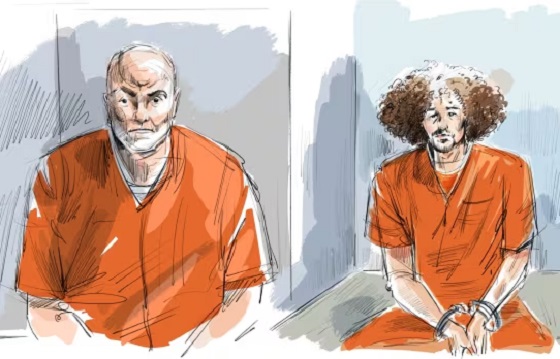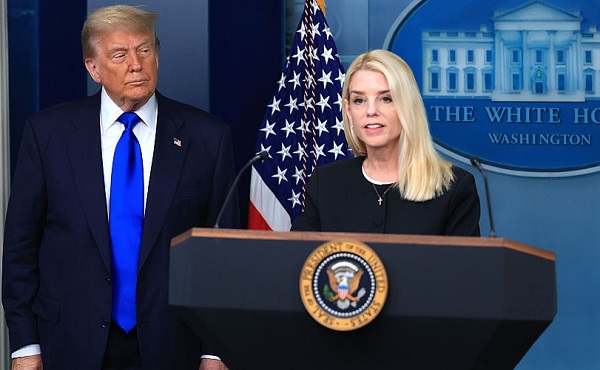COVID-19
The Rouleau Commission’s recommendations: Laundering the government’s agenda for censorship and expanded emergency powers

From the MacDonald Laurier Institute
By Ryan Alford
In this commentary, Ryan Alford examines how the Rouleau Commission’s personnel, agenda, and fundamental assumptions were all determined by Cabinet, the very body whose actions it was charged with assessing.
On August 31, Minister of Public Safety Dominic LeBlanc issued a six month progress report on implementing the recommendations of the Public Order Emergency Commission (POEC), also known as the Rouleau Inquiry. It is notable for what it explicitly notes as being implemented, and for what remains to be implemented without significant comment. That said, it would be an error to begin with a comparison between what the Final Report of the Rouleau Inquiry recommended and what the federal government is now implementing. Rather, the critical point of comparison is between the Order-in-Council establishing the Commission – that is, Commissioner Rouleau’s marching orders from the Government – and the legislative agenda that is now being pursued.
The Emergencies Act itself calls for a mandatory public inquiry into “the circumstances that led to the declaration [of an emergency] being issued and the measures taken for dealing with the emergency.” Before the POEC, civil libertarians had understood this to mean that the mandate of any inquiry would be to examine whether the government had a reasonable basis to conclude threats existed to national security that could not be dealt with under any other Canadian law, and whether the emergency measures taken by the cabinet conformed to the Canadian Charter of Rights and Freedoms. In short, it was always assumed the Inquiry would have a tight focus on whether a national emergency, as defined by law, existed and whether the declaration (and every action taken under it) had been constitutional.
That reassuring assumption proved unfounded. In the Order of April 25, 2022, the Governor General in Council, on the recommendation of the Prime Minister, redefined the meaning of the “circumstances that led to the emergency”, which now included “the impact, role and sources of misinformation and disinformation, including the use of social media”. It also directed the Commissioner to “make recommendations, as pertains to the matters examined in the Public Inquiry, on the use or any necessary modernization of [the Emergencies] Act”.
Thus, cabinet dictated the fundamental assumptions that guided the Rouleau Commission. Two of these assumptions stand out from the others. First, that misinformation and disinformation on social media had a significant impact on the organizers and participants of the Freedom Convoy. Second, that the Emergencies Act might need “modernization”. Both of these premises are highly problematic and should not have been granted at the outset of the hearings (i.e.: prior to the admission of any evidence).
The hearings phase provided ample demonstration of the spuriousness of these assumptions. Witness testimony reiterated that the concerns of Freedom Convoy protestors were practical and political in nature. Many had been directly affected by vaccine mandates that curtailed their ability to work and travel. Others expressed the view that these mandates had expanded the powers of government beyond what was acceptable. While these might not have constituted an indisputable justification for a sustained and disruptive protest, there was no evidence presented in the hearings that the Freedom Convoy protests were predicated chiefly, or even substantially, on social media-borne misinformation or disinformation.
Second, the only testimony from witnesses that supported the notion that the Emergencies Act needs to be modernized came from those closest to the heart of the federal government, namely the National Security and Intelligence Advisor to the Prime Minister and the Clerk and Deputy Clerk of the Privy Council Office (PCO). The documents, chiefly emails, expressing their concerns about the purportedly antiquated requirements for declaring a public order emergency seemed to follow shortly after the Director of CSIS had circulated a memorandum conveying his opinion that these requirements had not been met.
Essentially, when the request to conclude that a public order emergency existed had been rebuffed by CSIS, the RCMP, and, most critically, the Intelligence Bureau of the Ontario Provincial Police, which was at the time coordinating on the ground intelligence collection, senior government bureaucrats started to express concern that the Emergencies Act and the CSIS Act were out of date.
Many observers found this claim unconvincing; not least because, unlike many pieces of public safety-related legislation – for instance, the Criminal Code – neither the Emergencies Act or the CSIS Act had been previously flagged as in need of updating as both are relatively modern pieces of legislation, enacted in 1988 and 1984, respectively. Notably, these laws themselves had been passed in response to the serious abuse of the War Measures Act during the October Crisis of 1970 and, in the decade that followed, the unlawful activities of the National Security Division of the RCMP, as detailed in the final report of the McDonald Commission (1981).
Accordingly, it was not surprising that, in the three decades since the enactment of these two laws, there had been no amendments that would have loosened the legislated restrictions on federal government’s ability to expand its own powers at the expense of Parliament and the provinces. The Order-in-Council nevertheless mandated that the Inquiry consider the issue of the “necessary modernization” of the Emergencies Act, and the Commission continued to take this directive seriously – even after it had become apparent that the argument that modernization was needed had originated in an internal dispute over whether a declaration of a public order emergency during the Freedom Convoy would be unlawful. (All of the police and intelligence agencies consulted by the government had concluded that the statutory and constitutional requirements for the use of the Emergencies Act had not been met).
What is even more problematic is the possibility that Cabinet had made the call to invoke the Emergencies Act on the premise that it was appropriate to measure the facts on the ground in Ottawa against the standard of an “evolved” interpretation of the Act (likely at the urging of senior bureaucrats). This may well have been the same logic employed by Minister of Justice David Lametti. We’ll likely never know for sure, owing to the Prime Minister’s assertion of solicitor-client privilege over a secret memo outlining the Justice Department’s legal argument for invoking the Act, which convinced the Cabinet to come to the opposite conclusion from the one stated in the Director of CSIS’ memorandum of the previous day.
Accordingly, by directing the Rouleau Commission to consider whether the Emergencies Act needed to be modernized, the Cabinet may have been clandestinely requesting that the Inquiry bless its novel (and secret) interpretation of legal definition of a public order emergency. This interpretation would, as such, receive a retroactive justification if the Commission were to conclude that the Minister of Justice had merely been anticipating the legislative changes needed to modernize the Act.
For obvious reasons, this request could not be made explicitly. If the Cabinet did, in fact, rely on the “evolved” definition in a closed-door meeting protected by Cabinet and solicitor-client privilege, this would be a constitutional abomination they’d rather not see come to light. The Emergencies Act specifies a narrow range of conditions that allow the Cabinet to assume the power of Parliament to pass laws – a problematic exemption from the basic principles of responsible government at best. If the Cabinet decided to surreptitiously amend the legislation that allows it to invoke these extra-parliamentary powers, it is effectively asserting the supremacy of the executive over the legislative branch. Cabinet cannot be confined within legal bounds if it reserves for itself a secret power to adjust these bounds outwards at will.
The second assumption embedded in the POEC’s mandate received more explicit treatment in LeBlanc’s progress report. It noted that the Final Report had charged the government with addressing “social media misinformation and disinformation”, and that the Commission had made specific recommendations that “the federal government work with its partners to further study the impact of social media . . . while addressing the serious challenges that misinformation, disinformation, and other online harms present to individuals and Canadian society”. Suffice it to say that Minister LeBlanc’s progress report makes it clear that this particular recommendation is being taken very seriously.
Of course, when the Cabinet directed the Rouleau Commission to provide recommendations related to social media misinformation, it had already reached firm conclusions about the need to implement far-reaching censorship of online expression. However, in purporting to merely be implementing the recommendations of a Public Inquiry, the federal government may be able to divert attention from the fact that some of the most contentious elements of this legislation have already been passed. This includes provisions that would allow the a committee established under the CRTC’s regulatory authority to assess and censor individuals’ social media posts. Additionally, it can point to the recommendations of the Rouleau Commission as a justification for the decision to funnel still more governmental funding to purportedly “neutral” civil society organizations and academic research centres that inevitably take the position that increased governmental censorship is necessary and justifiable. (See, for instance, Ontario Tech University’s Centre on Hate, Bias, and Extremism).
Indeed, this dynamic of finding purportedly neutral sources for highly contentious proposals was present within the Rouleau Commission itself. Having failed to obtain testimony that demonstrated the need for censorship and increased emergency powers in the Inquiry’s evidence phase, the Inquiry’s in-house Research Council commissioned (and paid for) submissions from a number of academics well-known for their advocacy, some of whom were affiliated with and even co-authored their submissions with notoriously politicized and ideologically biased organizations, such as the Canadian AntiHate Network.
Finally, when it came time for the culmination of the policy phase of the Inquiry, the roundtables charged with shaping the Commission’s recommendations were packed with experts with ties to the Trudeau government, notably exTrudeau Foundation CEO Morris Rosenberg. (Rosenberg was also the author of the report commissioned by the Privy Council Office that concluded that foreign interference had not affected the 2021 federal election; Rosenberg’s report concluded, contentiously, that “domestic actors” should also be a subject
of concern.)
On the question of whether the government will propose amending the Emergencies Act, LeBlanc’s progress report is considerably more evasive. This is likely because detaching the definition of a public order emergency from the definition found in the CSIS Act, as Rouleau recommended, would dramatically expand the federal government’s power to declare an emergency. If the legislative amendment tracks the Cabinet’s desires, the Emergencies Act could be triggered by any activity that threatens the “economic security” of Canada. As the more critical policy experts noted at the roundtable (and in their policy recommendations), this definition is practically limitless, as any disruptive protest (or strike, lockout, mass gathering, boycott, etc.) could have an “impact” on the national economy.
Accordingly, it seems likely that, before proposing such an amendment, the government will want to gauge the prevailing winds in Parliament. The surest indicator of unfavourable conditions would be the rigorous assessment of the Special Joint Committee on the Declaration of Emergency, which has equal status under the Emergencies Act with the Public Inquiry, and should not feel any need to defer to its findings – particularly as the Rouleau Commission’s personnel, agenda, and fundamental assumptions were all determined by Cabinet, the very body whose actions it was charged with assessing.
The Special Joint Parliamentary Committee can serve as a neutral judge, and it should exercise independent judgment when compiling its own definitive report. The Committee will be an especially important arbiter of the key issue of whether the federal government, having expanded the scope of its emergency powers in secret, should receive retroactive benediction in the form of a newly amended Emergencies Act, which would encompass responses to “economic threats” (an illusory limitation, to be clear). Such an outcome would make Cabinet, and effectively the Prime Minister, our true sovereign.
About the author
Ryan Alford is a Senior Fellow of the Macdonald-Laurier Institute, a Professor at the Bora Laskin Faculty of Law at
Lakehead University, and a Bencher of the Law Society of Ontario. He was also granted the status of a Party by the Public Order Emergency Commission and appeared in that capacity before the Rouleau Inquiry.
Business
Conservatives demand probe into Liberal vaccine injury program’s $50m mismanagement

From LifeSiteNews
The Liberals’ Vaccine Injury Support Program is accused of mismanaging a $50-million contract with Oxaro Inc. and failing to resolve claims for thousands of vaccine-injured Canadians.
Conservatives are calling for an official investigation into the Liberal-run vaccine injury program, which has cost Canadians millions but has little to show for it.
On July 14th, four Conservative Members of Parliament (MPs) signed a letter demanding answers after an explosive Global News report found the Liberals’ Vaccine Injury Support Program (VISP) misallocated taxpayer funds and disregarded many vaccine-injured Canadians.
“The federal government awarded a $50 million taxpayer-funded contract to Oxaro Inc. (formerly Raymond Chabot Grant Thornton Consulting Inc.). The purpose of this contract was to administer the VISP,” the letter wrote.
“However, there was no clear indication that Oxaro had credible experience in healthcare or in the administration of health-related claims raising valid questions about how and why this firm was selected,” it continued.
Canada’s VISP was launched in December 2020 after the Canadian government gave vaccine makers a shield from liability regarding COVID-19 jab-related injuries.
However, mismanagement within the program has led to many injured Canadians still waiting to receive compensation, while government contractors grow richer.
“Despite the $50 million contract, over 1,700 of the 3,100 claims remain unresolved,” the Conservatives continued. “Families dealing with life-altering injuries have been left waiting years for answers and support they were promised.”
Furthermore, the claims do not represent the total number of Canadians injured by the allegedly “safe and effective” COVID shots, as inside memos have revealed that the Public Health Agency of Canada (PHAC) officials neglected to report all adverse effects from COVID shots and even went as far as telling staff not to report all events.
The PHAC’s downplaying of vaccine injuries is of little surprise to Canadians, as a 2023 secret memo revealed that the federal government purposefully hid adverse effect so as not to alarm Canadians.
Of the $50.6 million that Oxaro Inc., has received, $33.7 million has been spent on administrative costs, compared to only $16.9 million going to vaccine-injured Canadians.
The letter further revealed that former VISP employees have revealed that the program lacked professionalism, describing what Conservatives described as “a fraternity house rather than a professional organization responsible for administering health-related claims.”
“Reports of constant workplace drinking, ping pong, and Netflix are a slap in the face to taxpayers and the thousands of Canadians waiting for support for life altering injuries,” the letter continued.
Regardless of this, the Liberal government, under Prime Minister Mark Carney, is considering renewing its contract with Oxaro Inc.
Indeed, this would hardly be the first time that Liberals throw taxpayer dollars at a COVID program that is later exposed as ineffective and mismanaged.
Canada’s infamous ArriveCan app, which was mandated for all travelers in and out of Canada in 2020, has cost Canadians $54 million, despite the Public Health Agency of Canada admitting that they have no evidence that the program saved lives.
Details regarding the app and the government contracts surrounding it have been hidden from Canadians, as Liberals were exposed in 2023 for hiding a RCMP investigation into the app from auditors.
An investigation of the ArriveCan app began in 2022 after the House of Commons voted 173-149 for a full audit of the controversial app.
COVID-19
Trump DOJ dismisses charges against doctor who issued fake COVID passports

From LifeSiteNews
Attorney General Pam Bondi has ended the federal prosecution of Dr. Michael Kirk Moore for giving ‘patients a choice when the federal government refused to do so.’
The Utah plastic surgeon who issued fake COVID-19 vaccine passports to help patients get around COVID vaccine mandates will no longer be prosecuted, U.S. Attorney General Pam Bondi announced Saturday.
During the COVID pandemic, Dr. Michael Kirk Moore Jr. and employees at his Salt Lake private practice developed a plan to provide patients who objected to being forced to take the vaccine with ineffectual, harmless saline injections instead and give them COVID vaccination cards that would satisfy (since rescinded) mandates to take the shot as a condition of employment, public facilities, mass gatherings, and more.
For his efforts, he was indicted for allegedly “endanger[ing] the health and well-being of a vulnerable population” and “undermin[ing] public trust and the integrity of federal health care programs.” The government also accused him of doing so for profit, but several sources attested off the record that Moore not only issued the cards for free but actually refused offers of compensation.
“They broke no laws and harmed no person,” the defendants’ legal team said in 2023. “Dr. Moore, specifically, abided by his long held Hippocratic oath to First Do No Harm. We believe he and his co-defendants will be found innocent of all charges.”
Last month, LifeSiteNews reported that Moore’s trial was set to begin on July 7, which could have potentially ended with him facing 35 years in jail and a $125,000 penalty. Supporters of the doctor had expressed worry that the change in presidential administration had not yet halted the prosecution.
Over the weekend, however, Bondi announced that at her direction it has now done exactly that.
“Dr. Moore gave his patients a choice when the federal government refused to do so,” she said. “He did not deserve the years in prison he was facing. It ends today.”
There is a large body of warning signs against the shots, which were developed in record time by the first Trump administration’s Operation Warp Speed initiative.
The federal Vaccine Adverse Event Reporting System (VAERS) reports 38,709 deaths, 221,030 hospitalizations, 22,331 heart attacks, and 28,966 myocarditis and pericarditis cases as of June 27, among other ailments. U.S. Centers for Disease Control & Prevention (CDC) researchers have recognized a “high verification rate of reports of myocarditis to VAERS after mRNA-based COVID-19 vaccination,” leading to the conclusion that “under-reporting is more likely” than over-reporting.
An analysis of 99 million people across eight countries published in the journal Vaccine “observed significantly higher risks of myocarditis following the first, second and third doses” of mRNA-based COVID vaccines, as well as signs of increased risk of “pericarditis, Guillain-Barré syndrome, and cerebral venous sinus thrombosis,” and other “potential safety signals that require further investigation.”
In April 2024, the U.S. Centers for Disease Control & Prevention (CDC) was forced to release by court order 780,000 previously undisclosed reports of serious adverse reactions, and a study out of Japan found “statistically significant increases” in cancer deaths after third doses of mRNA-based COVID-19 vaccines, and offered several theories for a causal link.
In January, a long-awaited Florida grand jury report on the COVID vaccine manufacturers found that while only a miniscule percentage of the millions of vaccinations resulted in serious harm based on the data it had access to, such events do occur, and there are “profound and serious issues” in pharmaceutical companies’ review process, including reluctance to share what evidence of adverse events they did find.
In May, Trump administration U.S. Food & Drug Administration (FDA) Commissioner Dr. Marty Makary and vaccine chief Dr. Vinay Prasad announced that there would no longer be blanket recommendations for all Americans to receive the shot, but the “risk factors” it would still be recommended for include asthma, cancer, cerebrovascular disease, chronic kidney diseases, a handful of chronic liver and lung diseases, diabetes, disabilities such as Down’s syndrome, heart conditions, HIV, dementia, Parkinson’s, obesity, smoking, tuberculosis, and more. Health & Human Services (HHS) Secretary Robert F. Kennedy Jr. subsequently announced COVID vaccines will not be recommended to healthy children or pregnant women.
The Trump administration has approved a new mRNA-based COVID-19 vaccine from Moderna, suggesting the federal government’s overall view of the shots will remain favorable, albeit without mandates of any kind. At the same time, it does require mRNA COVID shots to carry a new warning about the danger of heart damage in young men.
-

 Opinion1 day ago
Opinion1 day agoPreston Manning: Three Wise Men from the East, Again
-

 Uncategorized2 days ago
Uncategorized2 days agoCNN’s Shock Climate Polling Data Reinforces Trump’s Energy Agenda
-

 Addictions1 day ago
Addictions1 day agoWhy B.C.’s new witnessed dosing guidelines are built to fail
-

 Business1 day ago
Business1 day agoCarney Liberals quietly award Pfizer, Moderna nearly $400 million for new COVID shot contracts
-

 Business1 day ago
Business1 day agoMark Carney’s Fiscal Fantasy Will Bankrupt Canada
-

 Energy21 hours ago
Energy21 hours agoActivists using the courts in attempt to hijack energy policy
-

 Alberta14 hours ago
Alberta14 hours agoAlberta ban on men in women’s sports doesn’t apply to athletes from other provinces
-

 National14 hours ago
National14 hours agoCanada’s immigration office admits it failed to check suspected terrorists’ background






